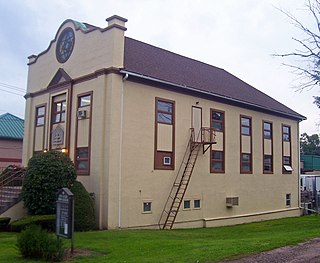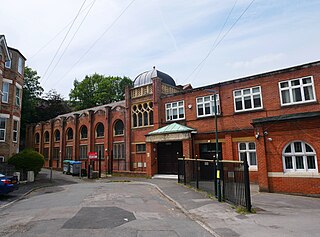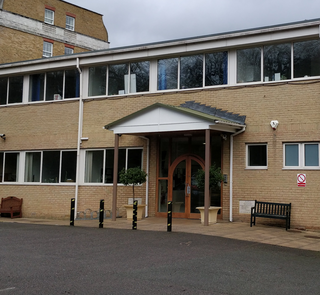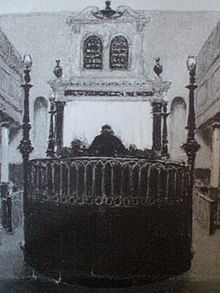
A synagogue, also called a shul or a temple, is a place of worship for Jews and Samaritans. It has a place for prayer where Jews attend religious services or special ceremonies such as weddings, bar and bat mitzvahs, choir performances, and children's plays. They also have rooms for study, social halls, administrative and charitable offices, classrooms for religious and Hebrew studies, and many places to sit and congregate. They often display commemorative, historic, or modern artwork alongside items of Jewish historical significance or history about the synagogue itself.

Simchat Torah, also spelled Simhat Torah, is a Jewish holiday that celebrates and marks the conclusion of the annual cycle of public Torah readings, and the beginning of a new cycle. Simchat Torah is a component of the Biblical Jewish holiday of Shemini Atzeret, which follows immediately after the festival of Sukkot in the month of Tishrei.
Torah reading is a Jewish religious tradition that involves the public reading of a set of passages from a Torah scroll. The term often refers to the entire ceremony of removing the scroll from the Torah ark, chanting the appropriate excerpt with special cantillation (trope), and returning the scroll(s) to the ark. It is also commonly called "laining".

The West London Synagogue, abbreviated WLS, and fully the West London Synagogue of British Jews is a Reform Jewish congregation and synagogue, located near Marble Arch, at 34 Upper Berkeley Street, in the City of Westminster, in Central London, England, in the United Kingdom.

The history of the Jews in Cincinnati occupies a prominent place in the development of Jewish secular and religious life in the United States. Cincinnati is not only the oldest Jewish community west of the Allegheny Mountains but has also been an institutional center of American Reform Judaism for more than a century. The Israelite, the oldest American Jewish newspaper still (2019) being published, began publication in Cincinnati in 1854.
Bury Hebrew Congregation, also known as Bet Knesset Sha'ar HahShamayim is an Orthodox synagogue, serving the Jewish community in the Sunnybank, Unsworth and Hollins area of North Manchester.

The South Fallsburg Hebrew Association Synagogue is a historic Orthodox Jewish congregation and synagogue, located on Lake Street in the hamlet of South Fallsburg, New York, in the United States.

The Bournemouth Community Hebrew Congregation is an Orthodox Jewish congregation and synagogue, located in Wootton Gardens, Lansdowne, Bournemouth, Dorset, England, in the United Kingdom. The congregation was formed in 1905 and worships in the Ashkenazi rite. The rabbi of the congregation is Adrian Jesner.

The Plymouth Synagogue is a synagogue in the city of Plymouth, England and the home of the Plymouth Hebrew Congregation. Built in 1762, it is a listed Grade II* building and the oldest extant synagogue built by Ashkenazi Jews in the English speaking world.
Bromley Reform Synagogue is a Reform Jewish congregation and synagogue, located at 28 Highland Road, in Shortlands, Bromley, in the Borough of Bromley, London, England, in the United Kingdom.

Beth Shalom Reform Synagogue is a synagogue in the City of Cambridge. Founded in 1981, it held services in hired premises until 2015 when the community opened a new synagogue on a site on Auckland Road, the first Reform synagogue in Cambridge. The new building includes a prayer hall for at least 200 people. The building was dedicated on 6 September 2015 at a service led by Fiona Karet Frankl and addressed by Rabbi Laura Janner-Klausner, senior rabbi to the Movement for Reform Judaism.
The Falmouth Synagogue was a former Orthodox Jewish congregation and synagogue, located at 1 Gyllyng Street in Falmouth, Cornwall, England, in the United Kingdom. Established in 1766, the congregation worshiped in the Ashkenazi rite.

The Wimbledon Synagogue, formally the Wimbledon and District Synagogue, is a Reform Jewish congregation and synagogue, located at 1 Queensmere Road, Wimbledon Park, in the Borough of Wandsworth, London, England, in the United Kingdom.
Belsize Square Synagogue is a continental Liberal Jewish congregation and synagogue, located in Belsize Park, Hampstead, in the Borough of Camden, London, England, in the United Kingdom. The congregation is independent of the two Progressive (Reform) Jewish movements in the United Kingdom, drawing from the worship tradition of German Liberal Judaism.
Kehillat Kernow (The Jewish Community of Cornwall) is a Jewish community with about 100 members in Cornwall, England, associated with the Movement for Reform Judaism. Founded in 1999, its name is a combination of the Hebrew word kehillat (community) and the Cornish word Kernow, meaning Cornwall.
Edgware & Hendon Reform Synagogue is a Reform Jewish congregation and synagogue, located at 118 Stonegrove, Edgware, in the Borough of Barnet, London, England, in the United Kingdom. The congregation is a member of the Movement for Reform Judaism and was formed in 2017 as a result of the merger between the Edgware & District Reform Synagogue and the Hendon Reform Synagogue communities. The merged community is located on the site of the former Edgware & District Reform Synagogue, and it is the largest synagogue in Europe; with a membership base of 2,500 families.
The Jewish Community of Berkshire is a Modern Orthodox Jewish community and synagogue based in Reading, Berkshire, England, in the United Kingdom. The congregation worships in the Ashkenazi rite.
Beit Harambam Congregation is a Sephardi Orthodox Jewish congregation and synagogue, located in Northeast Philadelphia, Pennsylvania, in the united States. Founded in 1978, its membership is largely composed of Hebrew-speaking Israeli expatriates. Started as a basement minyan, the congregation purchased a small home in the 1980s, which was subsequently destroyed by arson in 2000. With significant funding from the Philadelphia Jewish community, the building was restored. The synagogue was further expanded with a larger sanctuary and a social hall, completed in 2011.
Black Jews in New York City comprise one of the largest communities of Black Jews in the United States. Black Jews have lived in New York City since colonial times, with organized Black-Jewish and Black Hebrew Israelite communities emerging during the early 20th century. Black Jewish and Black Hebrew Israelite communities have historically been centered in Harlem, Brooklyn, The Bronx, and Queens. The Commandment Keepers movement originated in Harlem, while the Black Orthodox Jewish community is centered in Brooklyn. New York City is home to four historically Black synagogues with roots in the Black Hebrew Israelite community. A small Beta Israel (Ethiopian-Jewish) community also exists in New York City, many of whom emigrated from Israel. Black Hebrew Israelites are not considered Jewish by the New York Board of Rabbis, an organization representing mainstream Rabbinic Judaism. However, some Black Hebrew Israelite individuals in New York City are recognized as Jewish due to converting through the Orthodox, Conservative, or other Jewish movements.









